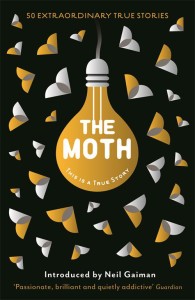 THE MOTH: THIS IS A TRUE STORY
THE MOTH: THIS IS A TRUE STORY
Edited by Catherine Burns
Allen & Unwin, May 2015, RRP $21.99
It is an opportune moment to review the printed collection, The Moth: This is a True Story. At the upcoming Melbourne Writers Festival there will be a session transporting The Moth from its natural habitat in New York to Melbourne. You should head across to the MWF website to purchase tickets if you have a chance. It’s likely to be a beautiful night of good stories well told, cunningly spun and woven and cast into the audience to lure you. As if to a flame.
For the stories are the flames here.
And The Moth was lighting candles on stage long before it was fashionable. Back in 1997 the writer George Dawes Green founded a little New York collective of oral storytellers relating to each other their stories of real things, real life, real times. It caught fire. It grew and grew. Now, of course, that sort of live real-experience storytelling has become a thing. You can attend and even get up on stage at similar events in Melbourne if you want to, but The Moth did it first, or close enough to first not to matter.
In The Moth: This is a True Story, we have a collection of real life stories told by various people on stage, for an audience, with all the art, wit and raw emotive heart that you would expect from good tellers of tales. There is a charmingly varied swathe of stories here too. These are not professional storytellers (well, alright, some of them are…), but rather these are people who have lived interesting lives and also happen to be able to paint a picture with words.
One of the most surprising and enchanting things for me is how well these written stories retain the bloody, ripped-open feeling of emotion, anxious public speaking nerves and the palpable, almost desperate urge to connect with an audience. This cannot be easy to capture on page: not all spoken stories settle gently into the written word. I can only think that the editor of the collection, Catherine Burns, has done a remarkable job picking stories that give the intense feeling of listening to a spoken story, even when simply read. She has given us that breadth of variety too. The collection skips through the human condition as it goes. Herein are stories that provide a sort of voyeuristic enthralment, stories constructing a moral compass to guide by, stories to inspire, stories to sadden, stories that restore faith in humanity, and stories that could well leave you enraged at the callousness of the same.
But my final impression, what really stuck with me at the close of this collection, was how much I felt that I could see a little bit into the minds of, and feel an empathy with, people whom I normally would have little or nothing to do with. If it had not been in this collection, I would probably never have taken the time to read a tale from a Texan Methodist preacher discussing an unusual Easter he experienced one year – and yet, I found this to be one of the more moving tales in the book. In contrast, I ought to have a lot of commonalities with Alan Rabinowitz, the founder of the big cat conservation group Panthera*, and yet his story left me… not cold exactly… rather…. well… the problem was I knew that story already, more or less. I knew who Alan was. I knew all about Panthera. I knew about conservation biology. But on the other hand, I didn’t really get what it was like to be passionate about being a Methodist preacher in Texas.
The stories of the people furthest outside my walk of life were the stories I found most deeply enchanting, and perhaps also these will be the stories most likely to leave a change behind in my own perspective. Now, this is precisely what good fiction is supposed to do: inform, delight, entertain, yes, but also give us the feeling of genuinely walking in a distinctly different pair of shoes for a while. Good fiction should leave us feeling like we have had the privilege of being someone else for a time. And yet, that is exactly what so much fiction fails to do. Too often it feels that an author of a fictive novel is only guessing what it is like to be this sort of person, or have those sorts of experiences. Compared to the pale, false flesh of guesswork, The Moth lets you feel the visceral innards of the speaker, laid bare, laid plain, laid open.
And so, I don’t just recommend this book to those who’d like to read a few good stories, but to would-be novelists also. If you can capture just half of the power of the voices in The Moth then you will be a long way towards writing very good fiction indeed.
* To explain, I hold a doctorate in biology and my research has tended towards conservation, thus some degree of things in common.
The Moth True Stories Told Live: MWF Event


